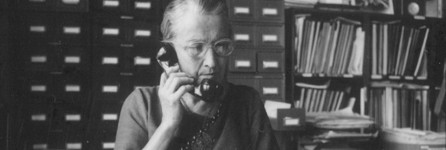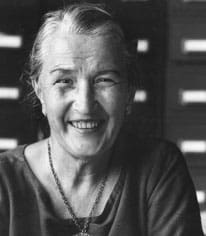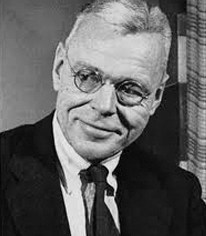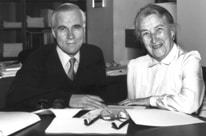
The first installment of the Ken Burns documentary Cancer: The Emperor of All Maladies, which aired Monday night on PBS, focused on the search for “magic bullets”—chemicals that could kill cancer cells specifically while sparing healthy ones. In the 1940s, pediatrician Sidney Farber took the first steps toward developing this approach, which became known as chemotherapy. Later, the discovery that mustard gas, a chemical warfare agent, could kill off bone marrow cells inspired institutions like the National Cancer Institute and Memorial Sloan Kettering to conduct ambitious screening programs of all sorts of chemicals—man-made ones and also ones isolated from plants, bacteria, and fungi—in the hopes of identifying one or two that might specifically smite cancer. At Sloan Kettering, the effort was led by Cornelius “Dusty” Rhoads, who would become chemotherapy’s greatest champion.
Around this time, another approach to cancer treatment was taking shape—or rather, being rediscovered. Helen Coley Nauts, founder of the Cancer Research Institute, was the daughter of William B. Coley, a New York-based surgeon. Nauts decided to write her father’s biography after his death in 1936. In the process, she discovered that her father had developed a novel—and surprisingly effective—treatment for cancer. The approach involved deliberately inoculating patients with mixtures of bacterial toxins, in the hopes of rallying the body’s natural defenses. Coley was inspired in the approach by the observation that patients who developed skin infections after surgery sometimes saw their cancers regress.
Still, she was convinced that there was something of value in the approach and spent years trying to convince leaders in the cancer field to study it.
Nauts spent several years poring over her father’s data, as well as conferring with doctors and tracking down still-living patients who had been treated with the toxins. Her conclusion was that the approach did, in fact, work in many instances. Unfortunately, Nauts discovered that there had been several different formulations of the toxins in use, not all of which were effective, and which led to inconsistent and often unreproducible results. Still, she was convinced that there was something of value in the approach and spent years trying to convince leaders in the cancer field to study it.
There were strong barriers to her success. Not least, Nauts was not a scientist. She had, in fact, never graduated from college and was working part-time while also raising two children. She was also a woman in a male-dominated and paternalistic profession. Most important, perhaps, was the tight grip that the chemotherapeutic framework had on medical thinking at the time. Correspondence between Nauts and Rhoads, dating from 1941 through 1950, illustrates the problems that Nauts encountered trying to convince the cancer establishment to change course.
Revisiting a Forgotten Approach
 Rhoads and Nauts met early in 1941 to discuss what Nauts called, “the critical historical analysis of the use of bacterial products in malignant disease, as developed by the late Dr. William B. Coley and other investigators, in the light of modern research.” At that first meeting, Rhoads agreed that the project was worthwhile and encouraged Nauts to assemble some case histories of patients treated in this manner. To assist her, Rhoads even helped Nauts to obtain library privileges at the New York Academy of Medicine to do research on the topic. The two continued to correspond as she undertook this work.
Rhoads and Nauts met early in 1941 to discuss what Nauts called, “the critical historical analysis of the use of bacterial products in malignant disease, as developed by the late Dr. William B. Coley and other investigators, in the light of modern research.” At that first meeting, Rhoads agreed that the project was worthwhile and encouraged Nauts to assemble some case histories of patients treated in this manner. To assist her, Rhoads even helped Nauts to obtain library privileges at the New York Academy of Medicine to do research on the topic. The two continued to correspond as she undertook this work.
Rhoads was periodically encouraging. “I think your idea described in your letter of Friday last is an excellent one,” Rhoads told Nauts on April 26, 1941. The following year, in October, he wrote again: “Please be assured of my very great interest in this problem and my desire to aid you in establishment of proof of the usefulness of the toxin.”
By October of 1942, Nauts had completed her initial write-up of case reports and sent it to Rhoads for his review. “I have just finished going through the lymphosarcoma material,” Rhoads wrote on October 15, 1942. “I find it very interesting, indeed.”
Nauts was clearly buoyed by Rhoads’s response, and the possibility that she might have interested the most powerful man in cancer research to reconsider her father’s approach. Her optimism jumps off the page: “We are beginning a completely new era in the use of the toxins, using new and more powerful formulae and a modified technique,” she wrote.
In prescient words that foreshadow the course she herself was to take 10 years later, she wrote, “I would like to suggest that you form a clearing house for information on the toxins which can help direct the treatment and the research during the first five years. Perhaps this could have an advisory council of the few investigators who have really contributed knowledge to this field.”
She then made “one last suggestion”: “You must be aware that no one else but me has so far made a detailed and painstaking study of all possible aspects of this form of treatment. Until such time as you may train a person with a more impressive medical background, I would suggest that you appoint me as a sort of registrar of information on the above mentioned Toxin clearing house.”
Not long after that, things began to go south.
Nauts’s ambitions clearly made Rhoads uncomfortable. She had already begun corresponding with leaders in the fields of bacteriology and cancer research, such as Murray Shear, William Woglom, and Gregory Shwartzman. When she proposed to Rhoads that he should collaborate with these scientists on a program testing the toxins at Memorial his reply was stern: “One paragraph in your note troubles me. You state that we are cooperating with Dr. Woglom and Dr. Shwartzman. This is emphatically not the case. I have not discussed this matter with either man and certainly could not commit the hospital to a policy of collaboration without clearance from the Scientific Committee.”
No doubt sensing that relations were beginning to strain, Nauts wrote on November 17, 1942: “I am sorry if something I have said or done has made you feel that this would have been inadvisable. I have talked about these problems at some length with Shear and Woglom and Shwartzman, and none of these men seemed to feel as you do about it. I do hope that whatever happens, you will feel that I shall welcome frank open criticism, directly.”
It was at this point that Rhoads decided to get a second opinion about Nauts’s claims about her father’s work. He wrote to a colleague, W. Osler Abbott, a blood cancer specialist, asking him to review Nauts’s data. Abbott replied to Rhoads on November 16, 1942, stating that although Nauts was a “strong partisan,” he was inclined to believe that her conclusions were sound, namely that “certain patients with lymphosarcoma which appeared highly malignant on section lived for a varying and often a striking number of years after the diagnosis was made….Of course it all hinges on the unanswerable question as to whether these cases fall outside the statistical expectation but I should guess that they probably do.”
At this point, the correspondence drops off for a few years, likely because it was the middle of World War II and Rhoads was directly involved in the war effort as an officer in the Chemical Warfare Division, where he was responsible for testing the physiological effects of chemical weapons such as mustard gas.
In July 1945, shortly after Germany surrendered, Nauts re-established contact with Rhoads, this time asking him to support her in her efforts to obtain a grant from the National Cancer Institute to continue her project. It is clear that by this time “the work” (as she called it) was becoming a full-time job, and she needed financial support to continue. Here again, Nauts ran into trouble. Her lack of medical credentials, and her status as a “free agent” unconnected with a major medical center, meant that she was unlikely to receive grant support from the NCI.
 Nauts also pursued the option of obtaining a job at Memorial, where, in addition to Rhoads, she also had a contact in the form of a family friend, a doctor named Henry Pratt, who was an administrator at the hospital. Nauts apparently asked Pratt if the hospital might hire her in some capacity or, even better, whether the hospital would sponsor her to receive a grant. On both counts, Pratt was dismissive, writing on May 5, 1947: “In the first place, I doubt that there is any vacancy in the hospital which your training would qualify you to fill.” With regard to the idea of the hospital supporting her to obtain a grant to pursue her research, he wrote: “I am sorry to say that the general feeling is that this would not be legitimate in that your activities would be in a field requiring extensive knowledge of medical problems and your lack of training in this field hardly qualifies you.”
Nauts also pursued the option of obtaining a job at Memorial, where, in addition to Rhoads, she also had a contact in the form of a family friend, a doctor named Henry Pratt, who was an administrator at the hospital. Nauts apparently asked Pratt if the hospital might hire her in some capacity or, even better, whether the hospital would sponsor her to receive a grant. On both counts, Pratt was dismissive, writing on May 5, 1947: “In the first place, I doubt that there is any vacancy in the hospital which your training would qualify you to fill.” With regard to the idea of the hospital supporting her to obtain a grant to pursue her research, he wrote: “I am sorry to say that the general feeling is that this would not be legitimate in that your activities would be in a field requiring extensive knowledge of medical problems and your lack of training in this field hardly qualifies you.”
This letter from Pratt clearly stung, for Nauts composed a sharply worded reply, which she never actually sent. After thanking Pratt for his frankness, she explained: “I naturally did not think I would rate as anything but an assistant. I knew that a few years ago people with less training than I had been considered or had actually worked there, and I just thought I would ask.”
Nauts acknowledged that the best solution would be for the National Cancer Institute or Memorial Hospital (“your outfit,” she calls it) to study her father’s approach. “I have felt, however, that the men who control the cancer field now are not very keen to go into the past, but rather hope that some new drug, enzyme, or bacterial product or mold may be discovered that is so powerful that one will not need to use a perfect technique of administration adapted to the stage of the disease or the type of neoplasm, and that therefore a meticulous study of the effect produced by Coley’s toxins, and various acute bacterial infections occurring spontaneously or by inoculation, are not particularly important at the present time.”
But Nauts stood by the value of her research agenda. There was no comprehensive historical analysis of the effects of bacterial infections on cancer. “There should be,” she wrote. “It is more than just a whimsy.”
On the matter of her qualifications, Nauts was biting: “Actually one can learn a lot in eight years without matriculating in a medical school.”
Finally, in her letter to Pratt, Nauts homed in on what she felt must lay behind the resistance of powerful men in medicine to undertake a careful study of Coley’s toxins. “Perhaps if someone were really interested in the problem, they would go over the material, and be fired up to do the job themselves. Of course it would be a little hard to admit that the idea and the material had been there for 55 years, without anyone being ready to dig into it hard. Perhaps that is what holds back any comprehensive study now. Well, I seem to have answered fairly frankly too. No hard feeling.”
Equivocal Evidence
Near the end of the decade, the correspondence between Nauts and Rhoads resumes. The letters go back and forth, with Rhoads continually asking for more evidence of the toxins’ effectiveness, and Nauts arguing her case.
On March 28, 1949, he wrote: “I think it would be useful if were you to take a series of patients with one or the other form of cancer in whom no other treatment was used than Coley’s Toxin, in whom the diagnosis was unequivocal, and present them in summary form.”
This would, indeed, have been convincing evidence. The problem, Nauts pointed out, was that most of these cases dated from several decades prior, and pathology specimens in many instances were no longer available. Moreover, in many cases, the toxins were given as a last resort after surgery and radiation. It was therefore not possible to present evidence from cases where no other treatment was used. “Perhaps what you are asking seems very reasonable and an easy thing to comply with,” Nauts wrote on April 19, 1949. “Unfortunately, I cannot supply the slides on four or ten cases in which no other form of treatment was given.”
Nevertheless, Nauts thought the data she had assembled provided clear evidence of benefit. “By studying the survival rates following surgery alone and surgery combined with toxins in operable cancer of various types (testis, breast, head and neck, malignant melanoma for example), I found that one could expect from 80 to 100 percent five year survival in such cases if the toxins were reasonably well administered, as regards site, dosage frequency, and duration of injections. This is a far higher percentage than one can get from the very best surgical procedures, with or without radiation.”
She then gets to the heart of the matter: “You have in the last eight years, since I first talked to you about toxin therapy, gone rather extensively into other forms of chemotherapy such as nitrogen mustards, radioactive iodine, hormones, etc. Does it not seem proper that a serious study be made of a method which has produced more dramatic and lasting results than any other known treatment of cancer?”
What seemed most exciting to Nauts was that bacterial infections and toxins seemed to operate through an indirect effect on the body’s natural powers of resistance. “The evidence indicates that it is by a stimulus to the reticulo-endothelial system,” she wrote. The reticulo-endothelial system was an early term for the immune system, before it was called the immune system. Here, Nauts introduced for the first time in her correspondence the idea that stimulation of the immune system might be an effective way to treat cancer. This was 1949. It is instructive to note that this is fully 10 years before Lloyd Old, Baruj Benacerraf, and Donald Clarke published their seminal 1959 paper in Nature on the role of BCG and cancer, which is commonly thought of as the beginning of the modern era of cancer immunotherapy (see Timeline).
Nauts clearly felt there was some urgency to the problem. She wrote in January 10, 1950: “I know you are terribly pressed for time, but it seems to me that many of the points outlined above have not received sufficient consideration….Please understand that my aim is not to push Coley’s toxins, but to discuss the broader aspects of this whole approach to the cancer problem. It may well be that by systematic studies suggested above, much valuable time may be saved, in avoiding mistakes that have been made in the past.”
Rhoads’s final reply to Nauts, dated January 11, 1950, is curt: “Our staff is presently supervising the largest program in the country on the subject which you discussed in your letter. I regret, therefore, that I am unable to help you with your problem at this time.”
The program Rhoads was referring to, of course, was the chemotherapy program. He had completely missed Nauts’s point.
Many years later, she learned that Rhoads had been more than just unhelpful; he had actively thwarted her efforts to raise money for her project.
A Later Discovery
Nauts would eventually give up trying to persuade Rhoads of the value of this approach. With help from her friend Oliver Grace, she took matters into her own hands and founded the Cancer Research Institute in 1953, with the goal of raising money to fund research into the immune system and cancer.
Many years later, she learned that Rhoads had been more than just unhelpful; he had actively thwarted her efforts to raise money for her project. In letters unearthed in the Rockefeller Archives, Nauts discovered that Rhoads had written to John D. Rockefeller Jr. to disparage both her research and her character. In 1941, Nauts had written to Rockefeller asking for financial support. Nauts thought Rockefeller might be willing to provide funding because he and her father had been friends for many years, and because Rockefeller had in fact supported his work previously. Not being an expert in cancer science, Rockefeller wrote to Rhoads asking him if he thought Nauts’s request for funds was valid. Rhoads was dismissive in his reply to Rockefeller:
“There is no basis whatsoever for Mrs. Nauts’ request for financial aid from you. Were she able to provide evidence that she can work effectively on this subject, I would be quite prepared to advance sufficient funds to provide secretarial help for her. We have a small amount of money which has been ear-marked for special purposes and could be used to aid Mrs. Nauts if it were deemed a wise expenditure. Unfortunately, I do not consider it to be so at the present time….It should be understood that Mrs. Nauts is an exceedingly eccentric individual who has very little insight into the intricacies and pitfalls of the project upon which she has embarked.”
 Fortunately, not all cancer researchers were as close-minded as Rhoads. Nauts would eventually recruit to her side several eminent researchers, including and especially Lloyd J. Old, himself a cancer specialist at Memorial Sloan Kettering, who would go on to serve as CRI’s medical director, and who is now considered the “Father of Modern Tumor Immunology.”
Fortunately, not all cancer researchers were as close-minded as Rhoads. Nauts would eventually recruit to her side several eminent researchers, including and especially Lloyd J. Old, himself a cancer specialist at Memorial Sloan Kettering, who would go on to serve as CRI’s medical director, and who is now considered the “Father of Modern Tumor Immunology.”
Dr. Old is a giant in the field who justly deserves credit for having spearheaded many of the most important breakthroughs in cancer immunology. But it is also important to note that Helen Coley Nauts helped to prepare the ground. Without her—and the organization she created to foster research in this new area—the field would not currently have legs to stand on.